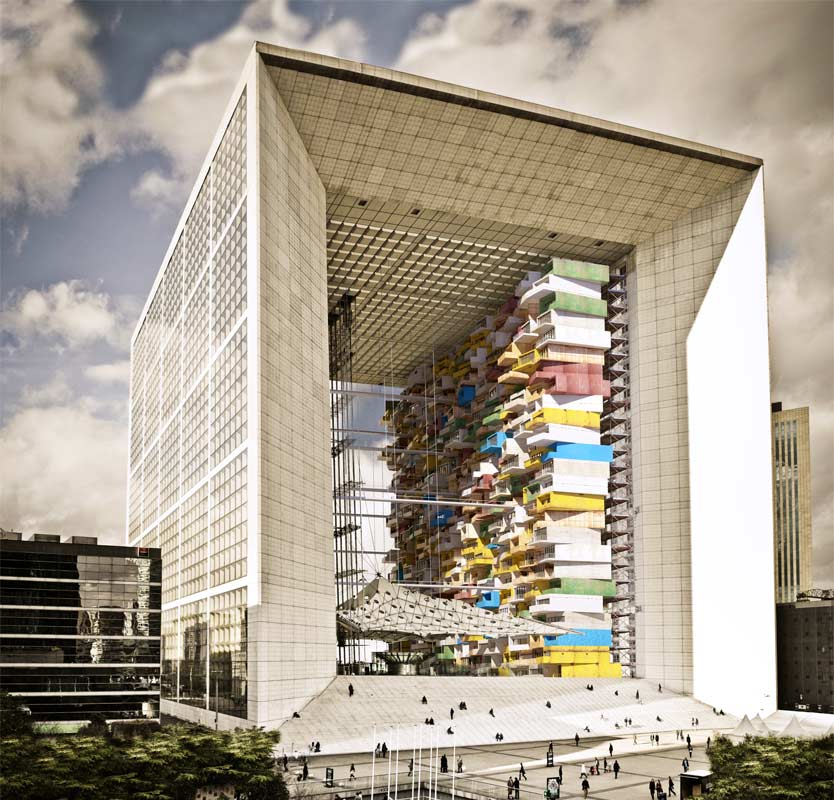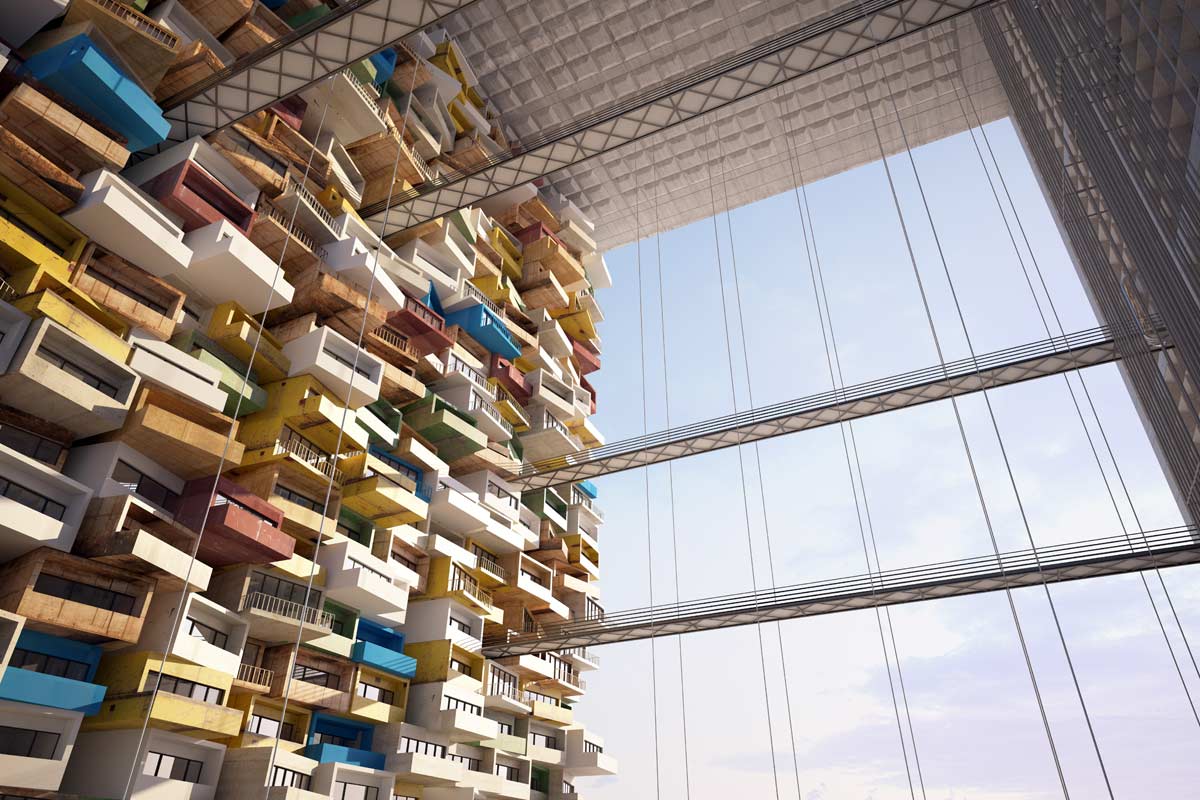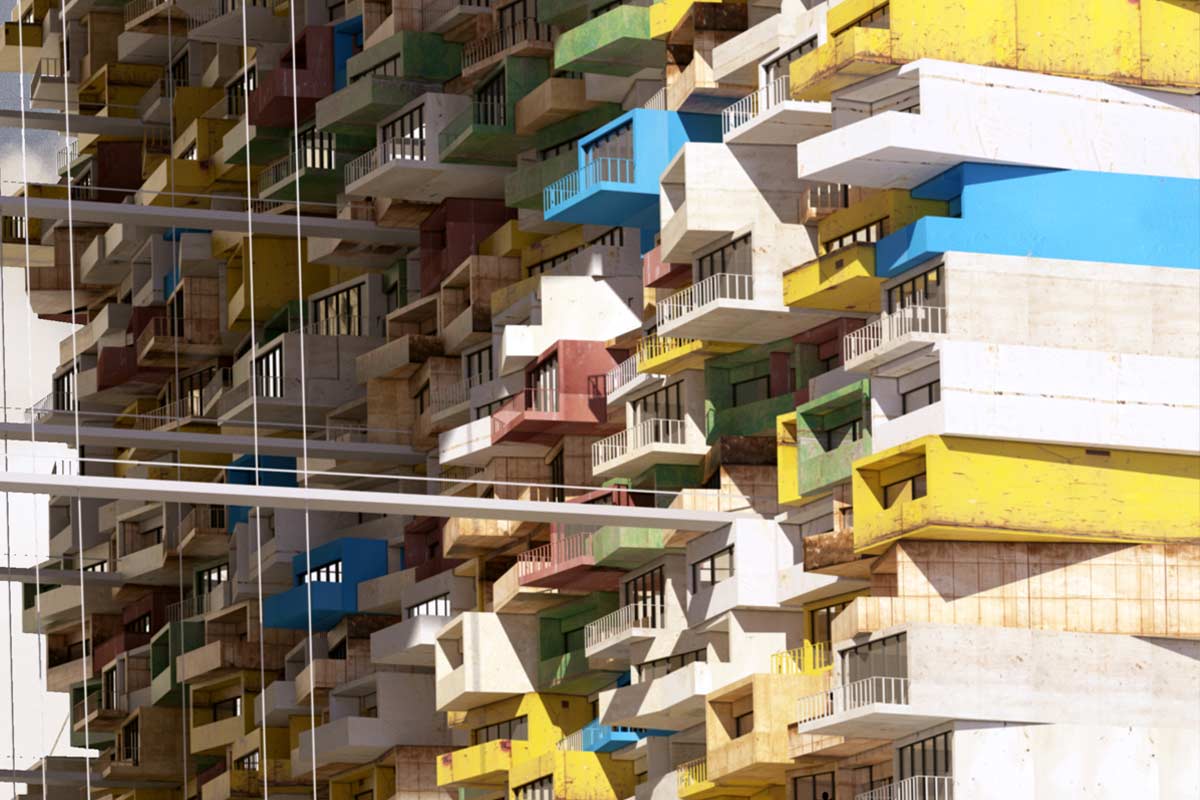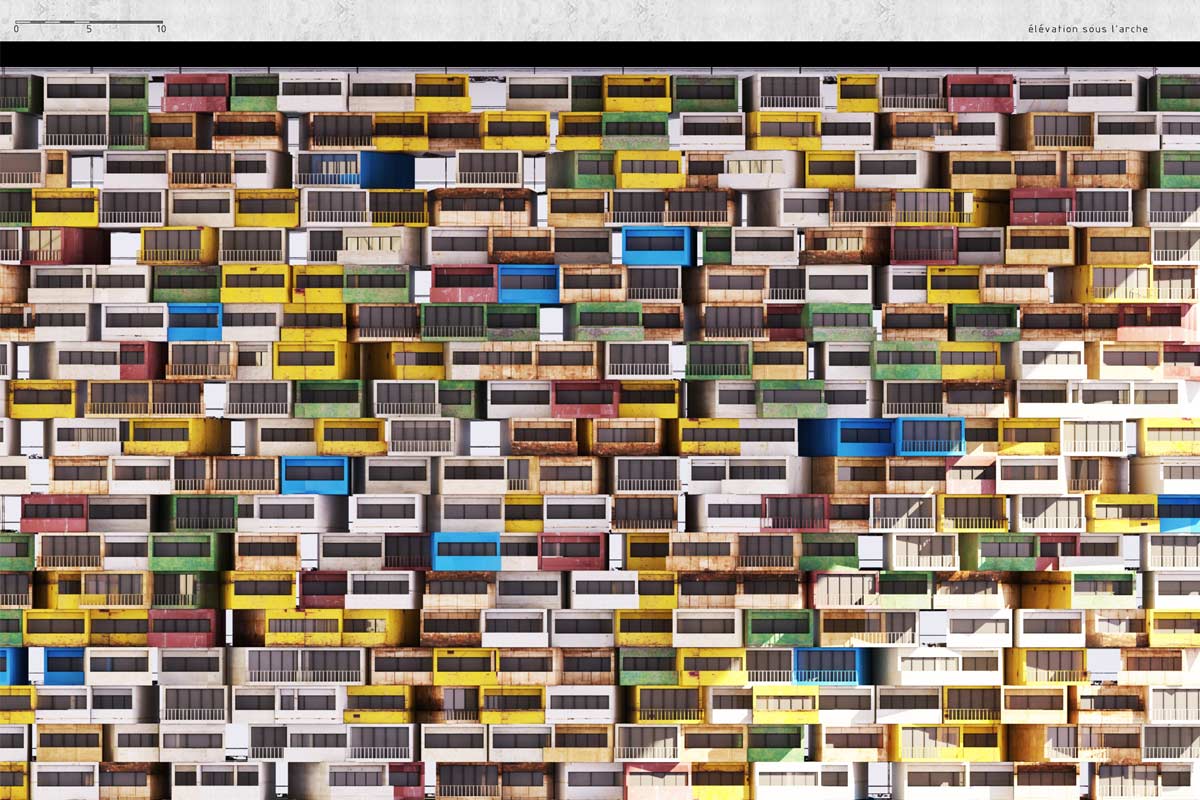 [Image: From Auto-Defense by Stéphane Malka].
[Image: From Auto-Defense by Stéphane Malka].
In the second of two projects by architect Stéphane Malka that I want to look at here, the Arche de la Défense in Paris has been transformed into a honeycomb of subsidiary spaces: encrusted with modules that have been attached to the inside of the existing building’s vast interior.
 [Image: From Auto-Defense by Stéphane Malka].
[Image: From Auto-Defense by Stéphane Malka].
As writer and curator Maryse Quinton describes it, “this study imagines the hijacking of a building that is symbolic for its monumentality and its location: the Arche de la Défense.”
A pocket of active resistance installs itself within the building in the form of a modular complex offering an alternative and militant lifestyle. The project bears with it a permanent insurrection and unites all malcontents, whether refugees, stateless persons, dissidents, outcasts or utopians. Referring to the notion of concretion, its construction principle allows for expansion tailored to the effervescence of this spontaneous community. It bases itself on the existing fabric using walkways grafted on to the lifts and a system of scaffolding leaning against the rear facade. A guerrilla architecture project that aims to hijack the great arch of fraternity.
In a detail that seems slightly tongue-in-cheek to me, Malka estimates that each module would cost only 3,000 Euros—as if you, too, could simply purchase your own plot of permanent insurrection, without need for a long-term mortgage or loan. Which leads me to wonder if there might someday be an insurrection bubble, with derivatives traded exclusively by Goldman Sachs.

 [Images: From Auto-Defense by Stéphane Malka].
[Images: From Auto-Defense by Stéphane Malka].
In any case, I really like this overhead view (below): the precarious spatial state of these revolutionary modules becomes readily apparent from above, as if this inspired reclaiming of urban space is really just one or two steps away from total collapse.
 [Image: From Auto-Defense by Stéphane Malka].
[Image: From Auto-Defense by Stéphane Malka].
These units, of course, could also very easily be adapted to other buildings or sites, just as symbolic for their monumentality and location, as Quinton writes; in Malka’s hands, the images would be equally breathtaking.
From U.S. Federal Buildings to overseas military bases; from the Kremlin to the Great Wall of China; from Parliament Square to historic battlefields; even as a structural cousin to Raimund Abraham’s Church on the Berlin Wall—a project I hope to write about soon—where else could Malka’s modular counter-utopias be anchored and what political scenarios might result?
Malka writes that architecture now “means reclaiming territory in the marginalized areas of our cities, with projects that bear insurrection and civic mobilization,” thus “creating new potentials for collective use.”
This methodology seeks to promote public participation as an act of resistance against urban restrictions. It is a colonization of neglected public spaces by the participation of a non-specialized labor collective that elaborates on prefabricated and hijacked construction systems.
As this and Malka’s Galerie Bunker project indicate, parasite spaces—and the incredible idea of “hijacked construction systems”—are one surprisingly fast way to begin rebuilding the modern city.
 [Image: From Auto-Defense by Stéphane Malka].
[Image: From Auto-Defense by Stéphane Malka].
For more, see Malka’s website.
(Earlier: Malka’s “museum for neglected spaces.” Related: projects by Santiago Cirugeda Parejo).

"… hijacking of a building…"
I just imagine how this would look like after having found the "pilot" (= facility management?) of the Arche de la Défense: "We are now redirecting this building to Cuba!"
"… precarious spatial state …" means: They are about to topple over?
This kind of "rebuilding the modern city" looks like putting up slum-like dwellings on purpose, albeit not very useful dwellings as access looks as precarious to me as their spatial state.
This reminds me of a proposal I saw once when working in an archival collection. The proposal was for a mobile home highrise hotel/apartment building. It was in the form of a wheel where you could slot a mobile home in the spokes around a large central elevator. It never really got built, but a very small scale version with six slots was constructed in Wisconsin(?) or Minnesota. It's been torn down now.
"What are you insurrecting against Johny?"
"Whaddya got?"
Interesting project.
I've got to wonder, though, why this kind of projected future seems more exciting than some other I can think of. Post-crash, we've seen a lot of dubious formal and ecological posturing that's more than worthy of criticism, and it's been good to see that claims about formal novelty or energy efficiency have been called out, here and elsewhere (I remember a great rant about "renderings of 'green' skyscrapers in the desert" from a while back).
Here we've got a project that seems just as unlikely, but the claims are about social justice and resistance, instead of sustainability and formal innovation. Aside from some tongue-in-cheek references to precarity and financing, there's little criticism of these claims.
I understand of course that these projects are intended as a provocation – but 3,000 euros? And why would the engineers of La Defense have built enough extra structural capacity into their Arche to hold up a shantytown in the sky? And why are they painted Cuban colors and tilted at arbitary angles, if not to suggest a picturesque favela chic? And why is this informality not present in the individual structures themselves? If not because it's easiest to just build four modules in sketchup and copy them 50 times?
I'm picking on this project, but it seems emblematic of a new trend – claims of social and economic justice are the new green, they deserve a closer look and more critique.
A project which "unites all malcontents in society"?
There is a tautology if ever there was one. Malcontents are averse to compliance with societal norms and reject the homogenisation of individuals. How can you unite them?
I think you can stand to be a bit more concrete in your language when you're describing something literally made of concrete.
I'm curious to know what they look like inside, and how the inhabitant relieves him(her)self. Do they have to climb down and find a public restroom, or is there some unit in the pod?